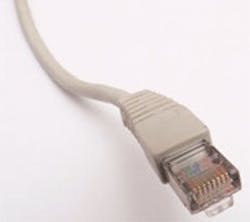With Great Power ...
Power over Ethernet (PoE) is the relatively new ability to provide low power, along with data, to devices via standard Ethernet cable.
PoE, however, is not so new that it already hasn't been standardized by IEEE. As explained in this issue's BandWidth column on PoE, IEEE's spec defines the powered device (PD) and the power sourcing equipment (PSE), a separate device typically installed in the wiring closet near the Ethernet switch or hub that inserts dc voltage onto the twisted pair cable and can be either an endpoint or a midspan device. An endpoint PSE contains both the data communication capabilities and the power-delivery mechanism, while a midspan only contains the power delivery mechanism and is inserted in the network between the non-PoE-capable Ethernet switch and the PD.
This past spring, PhihongUSA (www.phihong.com) claimed to have developed a PoE midspan product line capable of offering 95 W of power per port. The Phihong midspan's 95 W theoretically makes it suitable for high-power applications such as computer workstations, LCD panels and wireless-access-point arrays. Phihong says the new midspan provides IEEE 802.3af detection and disconnect, as well as pre-standard IEEE802.3at classification, and offers voltage, current and circuit protection.
[pullquote]Despite its claims of safety and pseudo-compliance, this is an example of a manufacturer reaching outside the realms of standardization and interoperability to push the envelope. But with great power comes great capability.
"As long as the IEEE 802.3 standard is followed, there are no risks, neither from the safety nor from the data damage point of view," says Daniel Feldman, PoE/PoE+ subcommittee technical chair of the Ethernet Alliance (www.ethernetalliance.org) and director of marketing for Microsemi (www.microsemi.com). "Currently, IEEE 802.3 supports supplying up to 12.95 W to the powered device on Cat. 3 and above cables. The IEEE 802.3at task force is working to modify IEEE 802.3 so it supports delivering 25.5 W on Cat. 5 and above cables, using two pairs of wires. The IEEE 802.3at standard is being written so it's feasible to deliver on a single Cat. 5 cable up to 51 W using four pairs of wires. It may or may not be safe, and data might or might not be damaged when a higher amount of power is delivered on a cable.”
The first and most obvious risk of some PoE products touting the ability to offer power as high as 95 W per port is the current capacity of the 24 AWG conductors, which in this application is roughly 500 mA per conductor, explains Eric Juillerat, president and CEO of Raven Technology Group (www.raventechllc.com). "Exceeding this can present cable failure probabilities," he says. "Some speculate that the combination of the cable and the RJ45 allow higher current ratings. However, I am not aware of any tests confirming this officially. I believe that PoE technology in the future will be capable of higher power, but at this time it is not practical.”
The risk of high power would be an introduction of noise into the system via the Cat. 6 cable, explains Doug Erlemann, business development manager-cameras for Baumer Group (www.baumergroup.com). "The 802.3 spec states that 13.5 W are required at the end of 100 m," he says. "Our cameras, for example, draw less than 5.5 W."
The biggest risk is that the power will be used for driving I/O output channels directly, which would quickly exceed the current limitation of IEEE 802.3af, exceed the current capabilities of the Cat. 5 data wires' conductors and also introduce excessive noise to the data lines, explains Joey Stubbs, PE, PMP, North American representative, EtherCat Technology Group (www.ethercat.org). "Keep in mind that the original purpose of PoE was to power low-wattage electronics such as Internet telephones, small microprocessors and LAN access points," he says. And regardless, 95 W still is low power and incapable of driving I/O or pneumatic valves, notes Stubbs.
Organizations that opt for high-power PoE products are purchasing products that aren't standards-based, warns Art Felgate, product manager, Transition Networks (www.transition.com). "The forthcoming IEEE 802.3at PoE+ standard will only support at most 30 W," he explains. "Ratification of this standard should occur later this fall. In the long run, those companies could incur unexpected, higher costs if they move from the non-standard solutions to standards-compliant ones."


